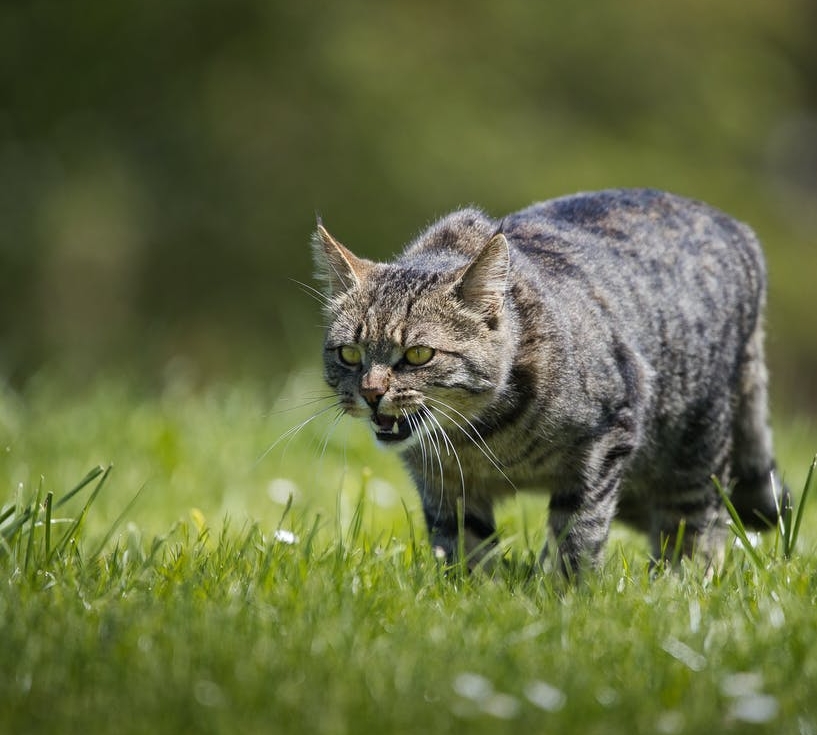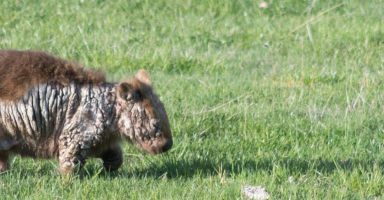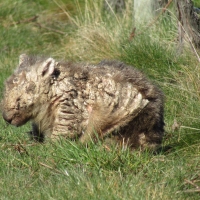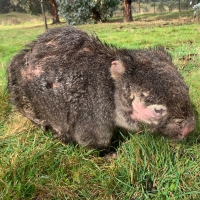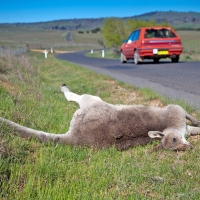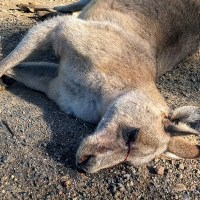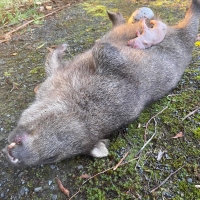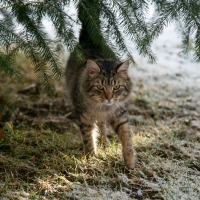There are many threats that impact our Tasmanian native wildlife and their habitat, contributing to their risk of extinction.
Major threats include land clearing, disease, invasive species and human interference and climate change.
Wombat mange
Our Tasmanian Wombats sadly suffer with Mange, Sarcoptes scabiei. It is a debilitating and often fatal condition.
The mites burrow under the skin and deposit eggs causing intense discomfort to the wombat. Over time thick plaques that look like scabs cover the wombats body, including the eyes and ears.
Feral cats
Cat-lover or not, none of us can escape the devastating impacts feral and roaming cats are having on Australia’s wildlife. Cats have contributed to the extinction of at least 22 Australian mammal species and the decline of many others.
They prey on over 400 native and introduced vertebrates in Australia. Most of the animals killed are native species.
Traffic
Dr Paul Donald of the Cambridge University Department of Zoology, coined the term ‘traffication’ to describe the encroachment of vehicles into the natural environment. Cars kill animals directly, with an estimated 500,000 lost on Tasmania’s roads each year. However roads also have other detrimental effects, especially through noise and light pollution. Some animals and bats will not cross noisy or lit corridors, restricting their range and therefore their viability. Podcast on ‘traffication’:
Forestry and land clearing
Forestry is a contentious subject, but whatever side of the political spectrum one sits, there is no doubt that logging, especially clearfelling in its various forms, followed by burning, disturbs and kills native wildlife. Some wildlife will move in response to disturbance, but the instinct of many is to stay in dens, tree hollows, and burrows where they feel safe. A recent report on native forestry, estimates up to 300,000 animals are killed or displaced by logging operations in Tasmania each year:
Land clearing continues on private land, often for the extension of grazing operations or to provide space for a house and garden. Some legal, some not. The Tasmanian State of the Environment report, notes that illegal or unapproved land clearing is having a significant detrimental impact on our wildlife:
Pets
Nationally, cats (ferals and pets) kill 1.5bn animals (reptiles, birds and mammals) each year. Unfortunately, precise figures for Tasmania alone are not available, but feral cats live in all parts of Tasmania, sometimes in high densities (eg around seabird colonies), and can kill animals up to 4kg in weight:
There are no equivalent numbers of wildlife deaths by dogs, although there have been some well publicised kills of multiple fairy penguins on Tasmanian beaches. 80% of penguin mortalities over recent years have been attributed to dog attacks.
Legal culling
In 2022, The Guardian reported answers from the state government regarding the numbers of animals reported to have been legally culled (either via shooting or the use of 1080 poison). Just under 860,000 native animals were culled in 2021, including Bennetts wallabies, rufous wallabies, brushtail possums, wombats, forester kangaroos, black swans, cockatoos (yellow-tailed and suphur-crested). This is probably significantly less than the actual numbers, with some landholders likely to be estimating or not reporting their kills, plus pouches may not be checked. Ongoing quotas include over 10,000 forester kangaroos. There are no limits to the numbers of brushtailed possums or pademelons that landholders can kill.
Extreme weather events
The black summer bushfires of 2019-2020 are estimated to have killed or displaced 3bn native animals. All bushfires and flooding events are known to heavily impact wildlife. Extreme events are on the increase owing to human-induced climate change. Climate scientists undertaking attribution studies, state that severe weather events will increase significantly in both frequency and severity:
What can we do to look after our native wildlife?
Private landholders have a huge opportunity to promote and provide havens for wildlife to thrive, and the rewards for us humans are equally large. Kids are naturally drawn to animals, and we lose some of that wonder as we grow up. Regularly closeness to nature and wildlife rekindles that awe and compassion, and helps us slow down and better cope with our day to day stresses and anxieties. Animals make us laugh, provide companionship, are fascinating and heart-warming to watch, and are vital components of the nature we are dependent on for ecological services. So often they are sadly seen as pests or thought to be so common that a few deaths don’t matter, whereas that is far from the truth.
Some of the things we can do, include the following:
Plant natives
Plant whatever you can wherever you can! Use a variety of plants so as not to only favour certain types of birds or animals. Native grasses are as important as flowering bushes and large trees. Vegetation gives creatures cover from predators, shade, den and nesting places and materials, food, and a sense of security. Plantings also hold soil and moisture, which is good for both you and the animals. Where possible, create wildlife corridors to link habitat areas between neighbours and between your boundary and the roadside. You can get heaps of advice regarding what plants to grow, from agencies such as Birdlife Tasmania, the Department of Natural Resources & the Environment (NRE) and your local Natural Resource Management division (NRM – sometimes with representatives in local councils).
Drive slowly dusk to dawn.
This is so important. Tasmania is the roadkill capital of the world – not a good look for us, and a poor outcome for our wildlife, already under siege from multiple threats. If everyone drove just 10-20kms/ hr slower at night, we could save millions of little lives. The roadkill we see is really just the tip of the iceberg, with many more injured animals crawling off into the undergrowth to die or live with disabilities. Often it is more than one life lost. An unchecked pouch may contain a viable joey, or a nursing Mum or nesting bird may well have young or eggs that will also die without care. You can also help by:
- putting up a sign on your own property urging drivers to take more care,
- talking to neighbours, friends and social networks about the issue,
- writing to the papers, and
- lobbying your local council and politicians of all stripes to:
- provide education and undertake awareness campaigns,
- reduce maximum speeds on many roads (or introduce variable speed limits between day and night),
- install signage (the flashing lights and smiley faces are especially effective),
- install wildlife bridges and tunnels on worse-affected roads, and
- remove authorisation for industrial trucks to travel on minor roads from dusk to dawn.
If you see a recently deceased animal on a road, please try and stop to check that it is dead and not just injured, check the pouch, and finally remove from the road to avoid scavengers also getting killed by a car or truck. It’s not just forest ravens that feed on carcasses, but also quolls, devils and raptors. If you find an injured animal or a joey that needs care, please call Bonorong immediately on: 0447 264 625. They may not answer but you can leave a message and someone will get back to you. This is always the best course of action, rather than resorting to social media or trying to care for an animal yourself. The joey is warmest and safest in Mum’s pouch if it is latched on, until rescued. An older joey can be wrapped in an old fleece or blanket and kept warm, quiet and dark. You can also report roadkill via the Tasmanian Roadkill Reporter app, which uses ARCGis mapping technology to build up a picture of roadkill hotspots. iNaturalist is another great way to record data on wildlife. Data is important, especially for decision-making at council, agency and government levels. Without evidential data showing need, it is hard for bodies to justify expenditure of ratepaper, taxpayer or donor money:
- https://nre.tas.gov.au/wildlife-management/living-with-wildlife/tasmanian-wildlife-roadkill/tasmanian-roadkill-reporter-app
- https://www.inaturalist.org/
Put out water
Bird baths and small pools are literally life-savers for native animals, reptiles, and even insects during dry periods. Having a permanent pool or bird-bath will also be a year-round drawcard to help improve biodiversity in your backyard. Frogs and insects needs ways to get to and from the water safely, so a couple of sticks or a ramp of rocks in the water will help them climb in and out.
Get involved in land restoration and citizen science projects
A great way to help wildlife is to join a local Landcare or Wildcare group, get your land registered as ‘Land for Wildlife’ through the Tasmanian Land Conservancy, and or volunteer at a local native plant nursery. There are also multiple agencies running citizen science wildlife monitoring and tracking programs. These include NatureTrackers, Wildtrackers, FrogID, Echidna CSI, the PlatyProject and many more! Some conservation groups also run bioblitzes in various locations, so look out for social media notifications. It’s a great way to get active, be in nature, meet friends, learn about our wildlife, and help them survive.
- https://tasland.org.au/programs/gfw/
- https://naturetrackers.au/
- https://www.wildtracker.com.au/
- https://www.frogid.net.au/
- https://www.adelaide.edu.au/environment/research/citizen-science/echidna-csi/echidna-csi-mobile-app
- https://platy-project.acf.org.au/
- https://www.inaturalist.org/
Reduce use of toxic chemicals
Pesticides, herbicides, even some ‘organic sprays’ and rat poisons, all threaten our wildlife and the balance of our environment. Spraying is sometimes unavoidable, particularly on large properties and in the case of pernicious ecocidal weeds, but we can use some methods to reduce harms:
- Research least toxic chemicals (including surfactants and dyes used with herbicides) and spot spray (where possible, as an alternative to boom spraying on large properties), when plants are small (so as to use the least amount of chemicals).
- Use pheromone traps and biological controls against pests (eg codling moth, sawfly). These are more expensive than sprays, but pay dividends by retaining insect biodiversity in your garden, which in itself helps keep ‘pest’ species under control.
- Use horticultural gauzes and fleeces over rows of veggies to reduce the influx of flying bugs wanting to lay eggs on your juicy young veggies, for their larva to feast upon – so you are not obliged to spray later on. Small wire hoops are sufficient to hold up the lightweight materials, which also stop birds eating your veggies.
- Use only first-generation rat poisons, since the second-generation poisons (which claim to kill quicker and are therefore often more attractive to someone with a rat issue) cause secondary poisoning to owls, raptors and other animals that feed on carcasses. This secondary poisoning is very difficult and expensive to treat, and is only sometimes successful. Better still, use mechanical or live traps, plus deterrents such as camphor and peppermint.
- https://www.landcaretas.org.au/rodenticides
Supervise your pets
Feral and straying pet cats take a terrible toll on our wildlife. Millions of animals are killed each year. Many of our smaller marsupials are both themselves uniquely vulnerable to cat attack, but also will eject their young from pouches in order to save themselves. Thus the harm is multipled. Many people cannot imagine that their affectionate pet cat is a killer, but research has shown that instinct takes over in most pets when presented with a prey opportunity. We know that cats don’t kill just for food, but also for fun and play. It’s a deep survival instinct for them, from before their symbiotic relationship with humans. Cats are amazing creatures and provide wonderful companionship to us humans, but it means we also have a responsibility to ensure they don’t harm our wildlife. Cats should be kept inside at all times. Catios have become popular, airy spaces that provide the cats with light and interest, and room for exercise. This can be as simple as a deck enclosed with aviary mesh and need not be too costly. Please also ensure your cats are desexed when young, so that should they escape, they will not inadvertently add to the number of feral kittens born each year.
Cats also harm our wildlife indirectly through the spread of toxoplasmosis. This is a horrible pathogenic parasite that needs cats and rats for its life cycle. The parasite takes control of a rat’s brain making it less fearful of predators, such that it’s easy prey for a cat. The cat sheds the parasite eggs through its faeces which are eaten or spread into surrounding soil. Toxoplasmosis can infect most mammals and marsupials including us humans. We’ve probably all seen half-blind pademelons hopping in circles during daylight, until they finally die. It’s a ghastly disease. It's also something we want to avoid as humans. Pregnant women’s foetus is at risk from the disease, and it has also been identified with fatigue, muscle pains and other harmful effects in adults. It is also suspected of having neurological effects, which may make the infected person more liable to take risks.
- https://nre.tas.gov.au/Documents/CATS
- https://nre.tas.gov.au/invasive-species/invasive-animals/invasive-mammals/feral-cats
Control dogs
There has been less attention on the harms dogs have on our wildlife, but we must all have seen the sad reports of mass fairy penguin massacres on beaches. There are few wild dogs in Tasmania (unlike our plague of feral cats), but straying dogs and even dogs in gardens and on properties, kill and terrify many animals. Many of our marsupials will die of shock after being chased and hugely stressed by a predator, so it doesn’t matter that the dog does not actually catch the animal. Dogs tend to be territorial and many are left in gardens while their owners are at work. Any animal that strays into the garden, or bird that lands on the ground, is liable to be killed, injured or greatly frightened. Animals at particular danger from dogs include possums, quolls, bandicoots, reptiles and small wallabies, potoroos and bettongs. Also in Tasmania, we have many ground-nesting birds, including along our coastal strips and dunes. Keeping dogs on leads when out walking in nature is really important for the safety of such birds and all our small native animals.
Bird strikes
Believe it or not, there are 1,000s of birds killed by flying into our windows each year. Simple things you can do to help include: Closing blinds or curtains when you’re not going to be around, putting silhouettes of raptors or cats on your windows, and putting anything up that makes the window more visible as a solid object. Some people go to the lengths of putting up parallel lines of thread or wire on the outside, to appear like thin bars:
If you are a farmer or large landholder, there is far more you can do, and arguably it is the large landholders that have the greatest responsibility to care for the environment and our wildlife – and the most to gain from the ecological benefits of increased biodiversity and an improved environment.
Reduce culling
Use fencing and other deterrents, rather than shooting and poisoning. We recognise that humans need food, and farmers need money coming in, but the numbers of animals lost through authorised shooting and poisoning are shocking. Sadly, 1080 poisoning is not banned in Tasmania, after the incoming Liberal government in 2014 reversed the earlier Labor-Greens government’s plan to phase it out by 2015. 1080 can be used under permit issued by Biosecurity Tasmania to protect crops, where ‘fencing’ and ‘shooting’ has proved ineffectual. It can be used to target brushtail possums, Bennetts wallabies and pademelons. However, there is no guarantee that baits won’t also be eaten by bettongs, potoroos, wombats or bandicoots. The bait is generally small cubes of dosed carrot, which is attractive to a range of native animals, and even birds. There is no legal requirement to remove poisoned carcasses, which raises the risk of secondary poisoning to scavengers. Although not generally fatal, secondary poisoning nonetheless can make the animal ill and less able to care for itself and offspring. It also presents a huge threat to pet dogs, many of whose owners are calling for a ban on the use of 1080:
Although expensive, fencing for wallabies and possums can be extremely effective, but requires regular monitoring. NRE can supply booklets on fencing types, with the favourite being small hexagonal mesh or ‘wallaby’ ringlock with an attached ‘skirt’ against the ground. Preparing the ground first to ensure a flat surface, will make for a more effective barrier against pademelons, who act like small wedges when trying to push under fences. Tent pegs or rocks can be used to hold the ‘skirt’ in place where necessary. Possums are deterred by strong electric fences and/ or mesh fences with an out-turned top (high enough that they can’t jump up onto it, eg 1200mm). Fully electrified fences or those with external electric outriggers need by no more than 1000mm to keep possums out (providing there are no overhanging branches or wooden posts to provide access from outside). Bennetts wallabies will similarly be deterred by a 1200mm high fence. Likewise native hens (often killed by growers of salad crops) are unlikely to negotiate a high mesh fence:
Wombats are often targeted by farmers because they push through fences and may browse on succulent crops. If it is important to deter wombats, electric fences with at least one strand around 250mm above ground, will generally do the job (electric strands lower than this can trap echidnas). If the primary goal is to keep out wallabies, stress on fences from wombats can be alleviated by the use of wombat gates. These are small top-swung ‘gates’ fitted into the fence where wombats are regularly pushing through. They can be simply made by using a wooden frame covered in mesh and hung with wire. The gate should be around 3kg in weight, to prevent the possibility of wallabies also pushing through. Such gates are also used by echidnas! It is surprising how quickly animals learn to use these access points:
- https://nre.tas.gov.au/Documents/Wombat-gate-design.pdf
- https://www.facebook.com/watch/?v=4448519635269661 (video of wombat gate in use)
If a fence is constructed of mesh or ringlock with holes smaller than say 100mm x 100mm, it might be difficult for quolls, bandicoots and native hens to get from one side to another. Making small access points for these animals is a great way to extend their range and help them thrive.
Protect poultry against quolls, rather than killing the quolls. Quolls are clever, inquisitive and charming animals and have the useful quality of helping to control rats and mice. Poultry and their eggs will generally be safe during the day, but they need locking up securely at night, in a pen or coop that is well-protected. Small mesh (less than or equal to 40mm holes) is sufficient to keep all but the tiniest quoll out, but needs to be dug into the ground, or to have a wide skirt pegged securely to the ground, possibly also protected by external electric. If hens are being locked into a coop, just ensure all chinks greater than 40mm are covered and there is no access from underneath.
Automatic pop-door openers are available now fairly cheaply and will close and open according to light levels or on a timer.
Leave wildlife corridors
One of the best things a landholder can do when installing fencing, is to leave generous wildlife corridors around the edges, especially where the land butts up against a road. So often animals are channelled onto roads with wallaby fencing right up against the roadside on both sides, which makes them horribly vulnerable to cars. Likewise wildlife corridors between farms and even between paddocks, are especially useful. These can be planted with natives and provide habitat for animals and ecological services for the farmer (moisture retention, homes for beneficial insects and pollinators, shade for soil and livestock). Animals need more than just fragmented areas of habitat, they need to travel to breed, find safe denning spots, and find food and water. Isolated populations are generally not sustainable unless the area is 100s of hectares and provides ideal habitat conditions. Even within fences, cropping operations that leave wild headlands around the crops are a big benefit to wildlife, as well as harbouring beneficial insect populations.
Keep livestock out of creeks and seasonal streams
Platypus, crayfish, frogs and native fish and invertebrates, rely on clean, free-flowing creeks and streams. Livestock, especially cows, excessively pug riverbanks, browse on riparian vegetation which helps hold together the banks and dampen the effects of floods, muddy the waters and pollute with excess nutrient levels. There are often grants available for fencing and restoring creeks, including from Greening Australia and other national and state agencies.
- https://www.bellingerlandcare.org.au/wp-content/uploads/Fencing_WaterwaysV2.pdf
- https://www.greeningaustralia.org.au/
Regenerative farming
It goes without saying that the more ‘natural’ a farming enterprise, the better it is for the environment, by reducing the outflow of nutrients, improving soils and soil-life, keeping water on farm (using swales, dams, plantings), and shading and wind-proofing for livestock and crops. Bandicoots and currawongs often do a lot of ‘tilling’ on no-till farms! Plus they eat many of the harmful grubs such as corby and cockchafer which feed on grass roots, and turn over and break up cowpats.
Councils and governments have a big role to play in protecting our wildlife. Things we could be lobbying for include:
- Roadkill prevention measures
- Inclusion of forestry in the EPBC Act (better still a phase-out of native forestry)
- Greater monitoring of wildlife numbers, especially over time, and research into what they need to survive and thrive
- Land use planning that gives planning authorities the power to demand wildlife corridors, habitat retention and plantings, from would-be developers, while also preventing urban sprawl and continual habitat clearing and fragmentation
- Banning of the use of 1080 poisons
- Grants for fencing and land restoration
- Education and awareness campaigns on the importance of our wildlife and natural environment
- Support for agencies and volunteers that showcase our wildlife and promote their value (eg movies like Quoll Farm and Roadkill Warriors).

